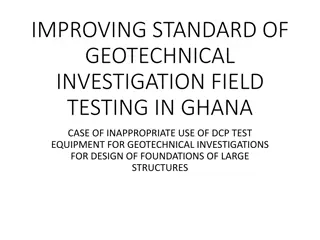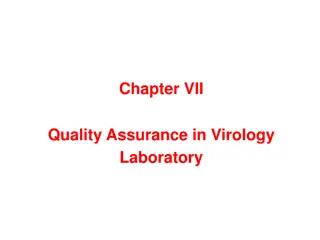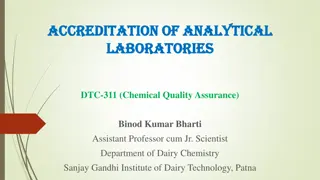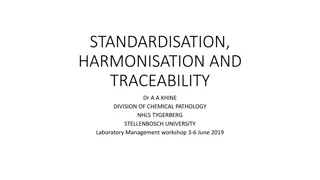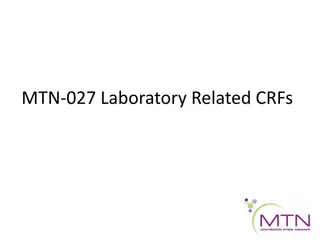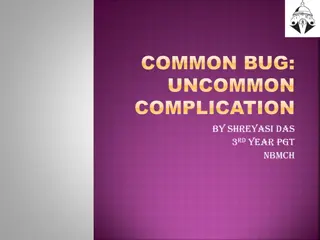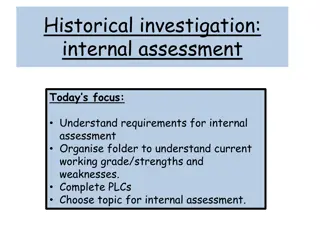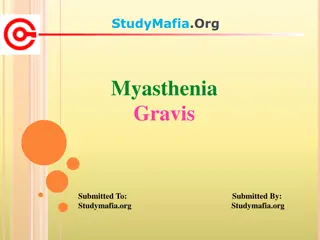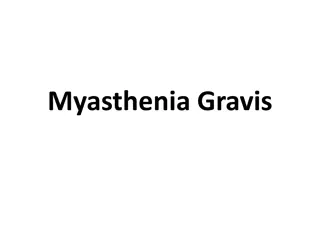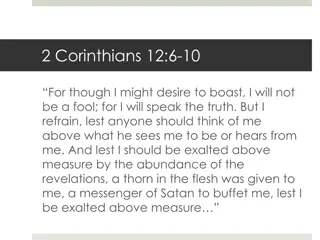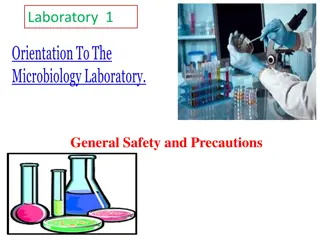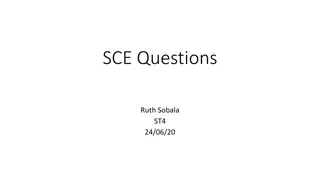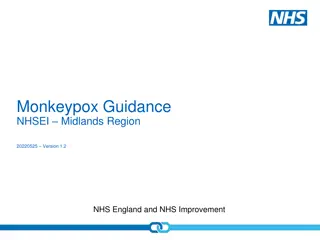Laboratory Investigation for General Body Weakness and Malaise
A case study of a 21-year-old post-graduate student presenting with symptoms including body weakness, malaise, pyrexia, headache, and loss of appetite. Laboratory tests reveal hemoglobin concentration, packed cell volume, blood smear results, and red blood cell indices calculations. Findings indicate possible causes for the symptoms and discuss the potential for hemotransfusion. Explore the patient's blood group compatibility for transfusion.
Download Presentation

Please find below an Image/Link to download the presentation.
The content on the website is provided AS IS for your information and personal use only. It may not be sold, licensed, or shared on other websites without obtaining consent from the author.If you encounter any issues during the download, it is possible that the publisher has removed the file from their server.
You are allowed to download the files provided on this website for personal or commercial use, subject to the condition that they are used lawfully. All files are the property of their respective owners.
The content on the website is provided AS IS for your information and personal use only. It may not be sold, licensed, or shared on other websites without obtaining consent from the author.
E N D
Presentation Transcript
PRESENTED BY GROUP 4 AKWASI ASAMOAH AIDOO GIDEON ASARE ISAAC OBESE SIS. ONYEOCHA PATRICIA FREMPONG SEKYERE JOSEPH PAPA GYANDEH BASOA FRANK PAPA DOMNIC OSEI KUFFOUR MARTIN
CASE STUDY A twenty one year old post graduate student reported at the university hospital with complains of general body weakness, malaise, pyrexia, headache, insomnia, persistent cough and loss of appetite. Perform the following laboratory investigation to aid the diagnosis of his ailment Haemoglobin concentration (conc of standard HiCN is 14.8g/dl and absorbance is 0.41 Packed cell volume Blood smear to screen for plasmodium infection ABO Rh D phenotype
CASE STUDY CONTND If the RBC count is 3.45 x 1012/L. Calculate MCV MCHC MCH A. Based on your findings, describe the morphology of the RBCs B. Discuss any clue based on your results which explains some of the patients symptoms C. You are asked if haemo-transfusion is an option in this patient s situation, explain your response based on your results. D. Discuss the possible blood groups the patient can be transfused with
SOLUTION RESULTS Haemoglobin concentration [Hb]= Absorbance of test x Concentration of Std Absorbance of Std Absorbance of test= 0.29 Concentration of Std= 14.8g/dl Absorbance of Std= 0.41 [Hb]= 0.29 x 14.8 0.41 [Hb]= 10.5g/dl
Packed cell volume 0.29 or 29% Blood smear screening for plasmodium infection No malaria parasites seen Blood group reporting TUBES TUBE 1 TUBE 2 TUBE 3 ANTI-SERA ANTI-A ANTI-B ANTI-D SAMPLE 20% CELL SUSPENSION 20% CELL SUSPENSION 20% CELL SUSPENSION RESULTS NO AGGLUTINATION NO AGGLUTINATION AGGLUTINATION Conclusion: the patient is group O Rh D Positive
RED BLOOD CELL INDICES CALCULATION DATA RBC count= 3.45 x 1012 g/dl Packed cell volume= 29% [Hb]= 10.5 g/dl CALCULATIONS MCV= PCV RBC count = 0.29 3.45 x 1012/L = 8.41 x 10-14 = 8.41 x 10-14 x 1015 = 84.1 fl
RED BLOOD CELL INDICES MCHC= Haemoglobin concentration PCV = 10.5g/dl 0.29 = 36.21g/dl MCH = Haemoglobin concentration RBC count = 10.5 g/dl 3.45 x 10 12 /L = 3.04 x 10-11 g x 1012 = 30.4 pg
DATA ANALYSIS MCV MCV is a measure of average red blood cell size. The normal range is 80 100 fL. MCV less than the lower limit : Microcytic Anaemia MCV within normal range : Normocytic Anaemia MCV greater than upper limit : Macrocytic Anaemia MCH Is a measure of the amount of haemoglobin per red blood cell The normal range is 27-32 picograms MCH less than the lower limit : Hypochromic Anaemia MCH within normal range is : Normochromic Anaemia MCH greater than upper limit : Hyperchromic Anaemia
DATA ANALYSIS MCHC Is a measure the concentration of haemoglobin relative to the cell size. The normal range is 31-36
DATA ANALYSIS From the above information, the patient sample which had an MCV of 84.1fL and MCH of 30.4 pg (all which are within the normal range) is inferred to have Normocytic Normochromic red blood cells. II. The patient presented with conditions such as general body weakness, malaise, headache and insomnia which could be due to factors such as low red blood cell count (anaemia). This was confirmed by the low PCV and [Hb] of the patient. The other red blood cell indices were normal indicating normocytic normochromic anemia. This could be due to chronic kidney disorders, aplastic anaemia, cancer and HIV among others. I.
DATA ANALYSIS The indications necessitating blood transfusion are anaemia associated with actual cardiac failure and major emergency surgery. Since the patients situation based on our results suggest none of these conditions, hemo-transfusion would not be an option. But further laboratory investigation should be conducted to rule out the parasitic causes of the anaemia if hemo- transfusion should be considered. In case of hemo-tansfusion, only packed cells would be transfused to avoid cardiac overload
THE POSSIBLE BLOOD GROUPS THAT CAN BE TRANSFUSED O Rh D POSITIVE O Rh D NEGATIVE reasons why the other can not be used A Rh D POSITIVE AND A Rh D NEGATIVE blood cell will react with o antibodies and cause haemolysis that can be fatal B Rh D POSITIVE AND B Rh D NEGATIVE blood cell will react with o antibodies and cause haemolysis that can be fatal AB Rh D POSITIVE AND AB Rh D NEGATIVE blood cell will react with o antibodies and cause haemolysis that can be fatal
PRECAUTIONS FOR THE LABORATORY TESTS Precautions during the investigations The blood sample was mixed well before for Hb,thick blood film and PCV analysis. This was done by inverting the anticoagulant tube 8-10 times For the blood grouping normal control and auto-control was set up
REFERENCES Monica Cheesbrough, District Laboratory Practice In Tropical Countries ,Second Edition, Part 2 American Association Of Blood Banks, Technical Manual, 10th Edition,1990.


